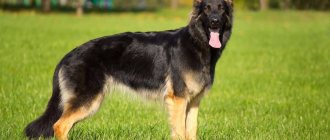The situation when you need to go somewhere with your pet is familiar to every breeder. In a car, a dog often feels uncomfortable; it is frightened by extraneous sounds and unfamiliar smells. The owner’s task is to help his four-legged friend cope with stress. It is possible that the dog will damage the interior of the car or distract the driver from the road. Inappropriate behavior of a pet can lead to an accident, so it is very important to prepare not only the dog, but also the vehicle itself for travel.
Problems with your pet’s well-being during transportation are caused by the influence of stress on its body.
How to train your dog to travel by car
Dogs do not like loneliness, and every pet is happy to accompany its owner anywhere. Unfortunately, not all four-legged animals easily adapt to new conditions. It is difficult to predict how a pet will tolerate transportation by car, so the trip must be organized in such a way that nothing causes discomfort to either the dog or its owner. The first meeting of a dog and a car should not be accompanied by negative emotions. Experts advise to act according to the following scheme:
- Open the car door.
- Call the dog to the car.
- If the pet wants to jump into the cabin, command “No!” and make sure the animal remains outside.
- Ask your assistant to start the engine and watch the dog’s reaction. If a pet is calm, it deserves praise.
- An agitated animal needs to be shown how easy it is to pacify the “steel horse.” To do this, you need to put your hand on the body, as if subjugating the car.
- The passenger should then be allowed to inspect the vehicle. You can walk around the car with him, touch the headlights and wheels. Let the dog satisfy its curiosity, sniff the “roaring beast”, and get used to the noise of the engine.
- Now the pet can get into the salon, and a treat should be waiting for him inside. Let your first acquaintance with the car evoke pleasant emotions.
- The dog should only jump into the cabin with the permission of the owner, as he may have dirty paws.
- The animal must also leave the vehicle upon hearing the appropriate command. This will allow you to gain confidence that your pet will not jump out of a moving car.
Contraindications to the use of sedatives
Do not forget that any remedy, even homeopathic, has a number of contraindications. Therefore, it is still worth giving certain medications, as mentioned above, after consulting a veterinarian. In addition, the use of sedatives during pregnancy, feeding kittens, and under the age of one year will be absolutely prohibited. Contraindications for health reasons include: renal or genitourinary pathologies, problems with blood pressure and vision, periods of illness of the animal. Also, under no circumstances should you give such a popular valerian to cats. Along with catnip, it causes narcotic intoxication and harms the health of the animal.
Rules for transporting animals in a car
Carrying a pet in a car is not prohibited by law; you can travel either in your own or in a rented vehicle, but you must adhere to the rules for transporting dogs in a car:
- The dog must not interfere with the operation of the machine.
- You cannot leave your four-legged friend alone in the cabin.
- The dog must be placed in a carrier or restrained using a restraint device.
This is interesting! There are organizations that provide services for transporting tailed passengers.
A dog should feel safe on the road
Across Russia
When you decide to travel around Russia with your dog, you need to pay due attention to collecting documents. To transport an animal you will need:
- veterinary passport;
- certificate in form F-1.
A veterinary passport is issued by a doctor at a private or public clinic after examining the four-legged animal. Veterinary certificate F-1 is issued at a regional veterinary clinic after a clinical examination by a doctor. These documents confirm the health of the pet and the absence of quarantine in the region where the animal leaves.
EU countries requirements
Traveling abroad with a dog must follow the rules established by the laws of the sending and receiving countries.
To travel abroad, a veterinary certificate and an international veterinary passport of an animal are not enough. Your pet must be microchipped and vaccinated against rabies. Some European countries have limited the possibility of importing animals into their territory. The measure is mainly aimed at fighting dogs.
On a note! When transporting a pet belonging to a rare breed, you should take care of obtaining permission from the Canine Association of the Russian Federation.
Breeders of four-legged animals with a pedigree need to obtain supporting documents from a canine or feline club. To do this, you will need to show your passport, inform the organization about the departure date and provide a plan for future travel.
You may also need a license, which confirms that the animal does not have breeding value.
Devices for transporting dogs
Manufacturers have provided different options for devices for transporting animals.
Plastic conveyor
A plastic conveyor is a device designed for transporting pets. The design ensures the convenience and safety of the passenger while driving.
Today you can buy containers of different sizes. The device is fixed in the back seat of the car using seat belts or the Isofix system.
Seat belts
Pet stores offer a wide selection of dog harnesses. The use of the design is aimed at securing the pet and reducing the risk of severe injury when accelerating or decreasing speed. The products are used together with harnesses.
Seat belts can only be used in the rear seat
Covers, capes, car hammocks for dogs
To prevent damage to the upholstery when transporting the animal, you need to use covers, seat covers or special hammocks. The devices do not allow the interior to become dirty and do not restrict the animal’s movements. Moreover, they are made from quality materials.
Car hammocks for traveling in a car over long distances occupy the entire area or the space of one seat, which depends on the size of the dog. The side part, reinforced with a zipper, protects the door from contamination and allows the animal to jump into the car without damaging the trim.
On a note! If you plan to transport it in the luggage compartment combined with the passenger compartment, it is better to use a cover. The animal will be very comfortable with it due to the soft sides.
Cages and partitions for the trunk
A cage and partition for the luggage compartment are the most popular means of transporting four-legged animals in a car.
Cell
An animal weighing less than 12 kg will tolerate traveling in a cage well. This design is made of metal rods and a pallet. To make your pet more comfortable, it is recommended to cover the bottom with a soft cloth. The cage can be placed both in the trunk and on the seat.
Partition
A partition is used to protect the cabin from pets traveling in the luggage compartment. The most suitable devices for this are a nylon mesh with clips for fastening, as well as sliding grilles. A partition is necessary to limit the dog's movement around the car. Otherwise, it will interfere with the driver, distracting him from the road.
Note! You can warn others that there is a dog in the car by using the appropriate sticker.
The partition is necessary to prevent the dog from distracting the driver from the road
How much does it cost to transport dogs and cats on different airlines?
AirlineOne way transportation priceAeroflot On flights within Russia - 3,750 rubles, on international flights from September 15, 2022 - 200 $ or € (depending on the route, previously it was only 75 $). UTair On direct flights within Russia: in the cabin - 3,000 rubles ., in luggage a pet weighing up to 20 kg - 3000 rubles, 21-30 kg - 6000 rubles, 31-50 kg - 9000 rubles. On direct international flights: in the cabin - 50 €, in luggage for a pet weighing up to 20 kg - 50 €, 21-30 kg - 100 €, 31-50 kg - 150 €. Ural Airlines On flights within Russia - 2500 rubles, in the CIS - 35 €, in non-CIS countries - 60 €. Pobeda Transports animals in a container with a total weight of up to 8 kg only in the cabin. 1999 rubles online and through the call center; 3000 rubles at a Russian airport; 55 euros at a foreign airport. Nordwind (“North Wind”) Transports animals only in the cabin. On flights within Russia - 2250 rubles, on international flights - from 35 to 62 $ or € (depending on the route). Turkish Airlines On flights within Turkey: in the cabin - 80 liras, in luggage for a pet weighing 9-15 kg - 120 liras, 16-22 kg - 180 liras, 23-28 kg - 220 liras, more than 28 kg - 260 liras. On direct international flights: the price is calculated by weight according to excess baggage rates, but not less than $70 in the cabin and $140 in the luggage compartment. Lufthansa On flights within Europe: in the cabin - 60 €, in the luggage compartment a container with dimensions of 60x45x40 cm – 100 €, dimensions up to 105×75×79 cm – 200 €. On flights outside Europe: in the cabin - 70–110 €, in the luggage compartment container with dimensions 60x45x40 cm - 130-190 €, with dimensions 105x75x79 cm - 260-380 €.Aegean AirlinesPrice depends on the season: from November 1 to December 31 and from January 1 to June 15 there is a low tariff, and from June 16 to October 31 there is a high tariff. On flights within Greece: in the cabin - 20/30 €, in luggage for a pet weighing up to 25 kg - 40-50 €, over 25 kg - 80-90 €. On international flights: in the cabin - 50-60 €, in luggage for a pet weighing up to 25 kg - 95-105 €, more than 25 kg - 160-170 €.airBalticIn the cabin - 50 €. In the luggage compartment: pet weighing up to 32 kg - 100 €, 33–75 kg - 200 €. Belavia In the cabin - 50 €, in the luggage compartment: pet weighing up to 32 kg - 100 €, 32-70 kg - 150 € .Alitalia On flights within Italy: 40 €, on international flights - from 75 € to 170 $ (depending on the route).Data current as of August 2022
Dog's first car ride
The first trip is a significant event for a pet. The breeder's task is to help the animal cope with anxiety and excessive excitement. Dog handlers recommend driving very quietly on the first trip so that the dog gets used to unfamiliar sounds and motion sickness. During subsequent transports, the speed can be increased; an accustomed dog will behave calmly.
Practicing canine psychologists claim that pets’ dislike of cars is usually due to the fact that their first trip is a trip to the veterinarian. The animal associates the car with the subsequent pain and discomfort that it had to experience in the doctor's office.
Accustoming a dog to a car should take place in a friendly atmosphere
How to train your dog to use a carrier or crate
Crate or carrier training for your dog requires patience. The following instructions will help with the habituation process:
- The door of the carrier should remain open for some time. The animal should not feel that it is trapped. Let your pet come and go as he pleases.
- At the bottom of the structure you need to place a comfortable bedding and toys.
- At the stage of training your dog, you need to put a bowl of food and treats in the carrier.
- Your pet should eat his favorite foods in a carrier.
- It’s a good sign if the dog allows himself to fall asleep in “his new home” - this means that the dog has stopped feeling anxious. It's time to close the door for a while. It is important that the owner does not leave the room and releases the animal when it wakes up.
- Over time, your four-legged friend will get used to being in a carrier with a locked door. After some time, you can leave the room for a while, but when you return, you must definitely praise the “little hero.”
Note! When you hear barking, you should not rush to your pet and release it. Otherwise, the dog will form a chain of “bark – pay attention – let go.”
When the dog learns to stay in the carrier for a long time, knowing that the owner is at home, you can begin to leave the apartment. The time away should be increased gradually.
Important! You cannot return to the apartment if your pet starts barking. The appearance of the owner should be preceded by calm behavior.
First thing
First of all, make sure that it is not easier to leave the cat at home. Here are some examples when it is better not to disturb a cat:
- The cat has nowhere to live. Imagine that you are going to visit relatives, and they are allergic to cats. It is easier to leave a cat in a hotel in your hometown than to rent out a hotel while visiting.
- Long quarantine. When crossing some borders, animals have to remain in quarantine for up to six months.
- Nervous character of the animal. Some cats are simply pathologically afraid to leave the house. Especially if they have never left the apartment, which is not uncommon now.
If your cat is an avid traveler, and the same cat lovers without a hint of allergies are waiting for you at the place of arrival, get ready for a trip. Cats have no business lying on the sofa!
How to deal with seasickness
To prevent your dog from getting motion sickness and to make the trip easier, transporting dogs in a car should be carried out taking into account the following recommendations:
- Stop feeding at least 2 hours before departure.
- Before leaving, be outside and get some fresh air.
- Do not close the window while the car is moving.
- Don't turn on the music.
- Avoid sudden acceleration and braking, and sharp turns.
- The interior should not smell of fragrances.
- Gradually accustom the animal to travel.
- Make regular stops and let your dog stretch.
We provide food and drink
Many owners prefer not to feed their pet on the road, but if the journey is long and the animal is accustomed to eating at a certain time, then you should worry about providing it with food and water.
The best food option. When choosing food, it is better to give preference to dry food or small packages with pieces in sauce, canned food. They will not spoil even if there is no refrigerator, and the cat will not get food poisoning. Fresh water is a must. An animal is thirsty because:
- experiences stress and “sweats” a lot;
- loses fluid during vomiting during motion sickness;
- overheats inside the car;
- eats dry food.
When to feed?
If the trip takes a little time, then it is better to feed the cat 30-60 minutes before departure.
On a long journey, the animal is fed according to a schedule or when the pet wants to eat. Water must be in the access area at all times. For convenience, you need to take with you bowls for food and water, from which the cat eats at home. Familiar containers will calm the cat.
Things to remember when traveling with a dog
When taking a long trip with your four-legged friend, it is necessary to make regular stops so that he can empty his bladder and bowels. You should not think that a healthy pet will walk under itself. Trying to endure it will adversely affect the functioning of the body. You need to go out into the fresh air at least once every three hours.
Important! During stops, the dog must be offered water. This will avoid dehydration and overheating.
The right transportation device is the basis for a successful trip.
What to do to prevent the omen from coming true
If a sign carries a negative connotation, do not be upset; sometimes the effect of a sign can be minimized. First, you need to calm down and remember that signs do not come true in 100% of cases. There are many ways to avoid the bad effects of omens:
- Use the anti-omen. You can knock on wood, spit over your left shoulder three times, look in the mirror;
- Try to mentally “erase” the sign. In consciousness, concentrate on the negative moment and forget it. You can write a superstition on paper and set the paper on fire. With ashes, everything bad is neutralized;
- Devalue the sign. You should try with all your might not to believe in the effect of the sign, to convince yourself of it.
Some people come up with their own effective ritual to avoid the influence of superstitions. There are many ways, the main task is to switch your attention from a negative attitude to a positive one.
Features of transporting large breeds
If you follow the advice of dog handlers, traveling with a large four-legged passenger will not cause any trouble. To do this, it is important to follow the rules:
- Using a hammock will create comfortable conditions for the dog to travel and will protect the seats (especially if they are leather) from possible contamination.
- It is necessary to stop feeding your animal bones at least 72 hours before travel. This delicacy increases the likelihood of motion sickness and vomiting.
- While on the move, it is extremely important to keep your dog hydrated.
- The animal should not be allowed to lean out of the window. This behavior can not only lead to a number of health problems, but also threatens the safety of people passing by, whom the pet may bite while the car is stopped.
- The dog should not be transported with a muzzle, as this may cause heat stroke.











